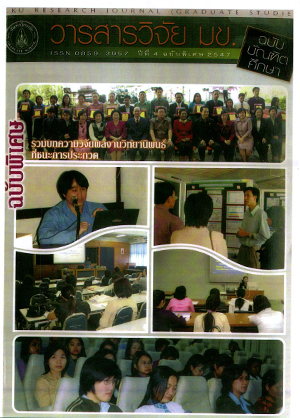ผลการจัดสิ่งแวดล้อมทางการเรียนเบนเครือข่ายที่พัฒนาตามแนว Constructivism: Open Learning Environment (OLEs) สำหรับนักศึกษาระดับบัณฑิตศึกษา สาขาเทคโนโลยีการศึทษา The Effect of Web-Based Learning Environments Developed Based on Constructivism: Open Learning E
Keywords:
Open Learning Enviromnment(OLEs), Constructivist Web-Based Learning Environment, Mental ModelAbstract
การศึกษาครั้งนี้มีวัตถุประสงค์เพื่อศึกษารูปแบบการทำความเข้าใจ (Mental Model) ความคิดเห็นและผลสัมฤทธิ์ทางการเรียนของผู้เรียนในกระบวนการเรียนรู้ วิชา 212 700 เทคโนโลยีการศึกษาและการพัฒนาการศึกษา ระดับปริญญาโท สาขาเทคโนโลยีการศึกษา จำนวน 15 คน โดยใช้รูปแบบการวิจัยแบบ One Group Pretest—Posttest Design และการวิจัยเชิงคุณภาพซึ่งเป็นการวิเคราะห์โปรโตคอล (Protocal Analysis) และการบรรยายเชิงวิเคราะห์ (Analytic Description) ผลการวิจัยพบว่า
1)รูปแบบการทำความเข้าใจของผู้เรียนในขณะที่เรียนจากสิ่งแวดล้อมทางการเรียนรู้บนเครือข่าย โดยอาศัยพื้นฐานในการวิเคราะห์รูปแบบการทำความเข้าใจอยู่ใน 2 ลักษณะคือ 1) 1) declarative knowledge 2) procedural knowledge (MerriLhboer, 1997) ผลจากการสัมภาษณ์ พบว่า ผู้เรียนสร้างรูปแบบการทำความเข้าใจในลักษณะของ Declarative knowledge เป็นโครงสร้างทางปัญญา (Schema) ที่เป็น Complex Schema ซึ่งผู้เรียนสามารถเชื่อมโยงหลักการ ทฤษฏี ไปสู่ปรากฏการณ์ที่เกิดขึ้น ทางด้าน Procedural Knowledge สามารถแบ่งได้เป็น 3 ลักษณะ ในแต่ละลักษณะพบว่ามีความแตกต่างกันตามลักษณะกลุ่มของผู้เรียน นอกจากนี้ยังพบว่ามีความสอดคล้องกับลักษณะการสร้างรูปแบบการทำความเข้าใจที่เป็น Declarative Knowlage จากการสัมภาษณ์ปรากฏว่า ผู้เรียนที่มีการสร้างรูปแบบการทำความเข้าใจในลักษณะของโครงสร้างทางปัญญา (Schema) ที่เป็น Complex Schema จะใช้กระบวนการทำความเข้าใจที่มีวิธีการหลากหลายโดยอาศัยคุณลักษณะของสิ่งแวดล้อมทางการเรียนรู้ที่ตอบสนองต่อการสร้างความเข้าใจ
2)ผู้เรียนมีความคิดเห็นต่อการเรียนจากสิ่งแวดล้อมทางการเรียนบนเครือข่าย ในทุกๆด้าน ได้แก่ (1) ด้านคุณลักษณะของสื่อบนเครือข่าย การออกแบบที่ช่วยให้ผู้เรียนค้นหาสารสนเทศได้ง่ายและส่งเสริมการเรียนรู้ (2)ด้านเนื้อหาที่ใช้ในการเรียนรู้ สารสนเทศที่จัดไว้สนับสนุนให้ผู้เรียนเกิดความคิดรวบยอดและนำมาใช้ในการแก้ปัญหาได้อย่างเพียงพอ (3) ด้านสิ่งแวดล้อมทางการเรียนรู้ สนับสนุนให้ผู้เรียนแสวงหาความรู้อย่างตื่นตัวทั้งร่างการและสติปัญญา (Active Learning) และเปิดโอกาสให้สร้างความรู้ได้ด้วยตนเอง
3)ผลสัมฤทธิ์ทางการเรียนของผู้เรียนที่เรียนจากสิ่งแวดล้อมทางบนเครือข่าย หลังเรียนสูงกว่าก่อนเรียน
This study aimed to examine the learners’ mental models, opinions and learning achievemcot in 212 700 Educational Technology and Instructional Development. The purposive group was 15 graduate students in Educational Technology by using web-based learning environment deveIop1 based on Constructivism: Open Learning Environments (OLEs). One Group Pretest—Posttest Design
and qualitative approach emphasized on protocol analysis and analytic description and dept1— interview were employed in this study. The findings are as follows:
- The formation of learners’ mental models which they constructed while they were learniè
from the web-based environments could be classified into 2 types:1) declarative knowledge ai’d2) procedural knowledge (MerriLhboer, 1997. For the findings from interview, found that the learners formed their mental models as Declarative knowledge which were complex schemas. The learners could relate the principles, theories to the real phenomena. For procedural knowledge, it could be claified into 3 types. Each type found that there was different according to the learners’ characteristics. Besides,
it also found that there was congruence with type of formation of mental models as Declaat knowledge. According to the interview, found that the learners had mental model formation as complex schema which would use various approaches in understanding process based on characteristic4cj web based learning environments which corresponded to the constructing understanding.
- The learners’ opinions toward web-based learning environments in all aspects are as follows:
(1) characteristics of web-based learning environments, which provide opportunity to search and iccess to information easily and also support learning. (2) The provided information can be supported cnpt formation of the learners (3) the web—based learning environments encouraged the learners to
in active learning both mental and physical as well as provide the opportunity for the learners to coti.4uct the knowledge by their own.
3. The learning achievement showed higher after the learners learning from web—based
Learning environment



